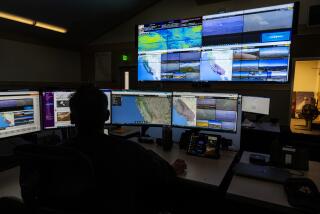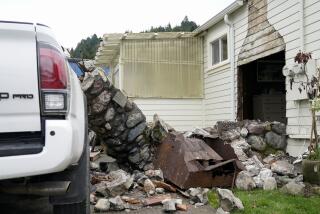GPS is getting an $8-billion upgrade
- Share via
Without it, ATMs would stop spitting out cash, Wall Street could blunder billions of dollars in stock trades and clueless drivers would get lost.
It’s GPS, and it’s everywhere.
Although most people may associate the Global Positioning System with the navigation devices that are becoming standard equipment on new cars, GPS has become a nerve center for the 21st century rivaling the Internet — enabling cargo companies to track shipments, guiding firefighters to hot spots and even helping people find lost dogs.
“It’s a ubiquitous utility that everybody takes for granted now,” said Bradford W. Parkinson.
He should know. Three decades ago, as a baby-faced Air Force colonel just out of the Vietnam War, Parkinson led the Pentagon team that developed GPS at a military base in El Segundo.
Now, scientists and engineers — including those at a sprawling satellite-making factory in El Segundo — are developing an $8-billion GPS upgrade that will make the system more reliable, more widespread and much more accurate.
The new system is designed to pinpoint someone’s location within an arm’s length, compared with a margin of error of 20 feet or more today. With that kind of precision, a GPS-enabled mobile phone could guide you right to the front steps of Starbucks, rather than somewhere on the block.
“This new system has the potential to deliver capabilities we haven’t seen yet,” said Marco Caceres, senior space analyst for aerospace research firm Teal Group. “Because GPS touches so many industries, it’s hard to imagine what industry wouldn’t be affected.”
The 24 satellites that make up the GPS constellation — many of them built at the former Rockwell plant in Seal Beach — will be replaced one by one. The first replacement was scheduled to be launched from Cape Canaveral this weekend. The overhaul will take a decade and is being overseen by engineers at Los Angeles Air Force Base in El Segundo, where Parkinson and his team developed the current system.
“We know that the world relies on GPS,” said Col. David B. Goldstein, the chief engineer for the upgrade.
San Diego found out firsthand in 2007, when the Navy accidentally jammed GPS signals in the area, knocking out cellphone service and a hospital’s emergency hospital paging system for doctors. New York experienced a similar problem a year later.
The upgrade is designed in part to prevent such outages by increasing the number of signals beamed to Earth from satellites that orbit 12,000 miles above. By triangulating the signals from four satellites, GPS receivers — and there are now more than a billion of them — can pinpoint your location on the ground.
Although “positioning” is an obvious application of the technology, it’s also become a crucial timekeeper for the financial industry. Transactions made everywhere, from ATMs to Wall Street stock trades, are time-stamped using precise atomic clocks ticking within the GPS satellites. The clocks are accurate to one-billionth of a second. It’s a crucial technology for Wall Street, where a fraction of a second could mean billions of dollars.
Before GPS, explorers and seafarers figured out where they were by looking at the sun and the stars. Even with the advent of gyroscopes and radios, navigation was still imprecise, with an average margin of error of a mile or two.
The Cold War sparked the necessity for something better.
When the Soviet Union launched the world’s first orbiting satellite, Sputnik, in 1957, scientists at Johns Hopkins University scrambled to track it. They soon realized they could determine Sputnik’s position by monitoring the radio waves it emitted.
That led to a breakthrough concept. If radio waves could be used to track a satellite from Earth, the radio waves from the satellite could also be used to determine the position of an object on the ground.
The Pentagon jumped at the idea. The Navy in particular needed help guiding its submarines that carried nuclear missiles. Because the submarines spent months underwater and only surfaced sporadically, they did not have a precise way of knowing where they were, which diminished the accuracy of the missiles.
In the 1960s, the Pentagon launched more than a dozen satellites under a program called Transit to help the submarines, which were outfitted with an antenna that could receive satellite signals when they surfaced.
But the system was accurate only to within 100 feet — and only when a submarine wasn’t moving. The government needed something better.
That’s where Parkinson came in. In 1972, the Pentagon tapped him to develop a satellite-based navigation system that had more naysayers than supporters. Parkinson recalled frequent trips to Washington to deflect criticism from politicians and even some Pentagon brass that decried the project as a waste of taxpayers’ money.
“I was told that the system was useless and that it had no future,” said Parkinson, 75, who is now professor emeritus at Stanford University. “I guess we proved them wrong.”
In addition to Rockwell, Parkinson enlisted engineers at Aerospace Corp., also in El Segundo. The first satellite was launched in 1978 and the system began partially operating with 21 satellites in 1993.
The military seized on the technology quickly, using GPS to guide troops through sand storms during the first Gulf War. A few years later, in 1995, GPS became a household name after Air Force Capt. Scott F. O’Grady used his hand-held unit to guide rescuers to his position after his jet was shot down over Bosnia-Herzegovina.
Since then, GPS has revolutionized warfare. GPS is used to direct the drones seeking out insurgents in Afghanistan, and has made “smart bombs” so accurate that they can be dropped from 40,000 feet and still land within 10 feet of their target.
The Pentagon operates and controls the GPS satellite system used in every country around the world. Until 2000 it deliberately degraded the signals that could be read by civilian devices. Commercial applications soared in 2000, when President Bill Clinton ordered the Pentagon to stop making the signals fuzzy.
Worried that the U.S. could flip the switch and shut off GPS to the rest of the world, several countries are developing their own satellites to wean themselves from relying on technology controlled by the U.S. military. The European Union, China and Russia are spending billions of dollars to develop their own versions.
Commercial applications, meanwhile, continue to multiply.
NavCom Technology Inc. in Torrance makes a remote-control system for tractors that steers by GPS. The company refines GPS signals with other ground-based navigation devices so that farmers can watch their tractors plant seeds in straight rows without overlapping in their fields.
Oil riggers pay a monthly subscription for a GPS service that enables them to zero in on oil fields that lay thousands of feet below the surface on the ocean floor.
The number of users who subscribe to such services is expected to balloon to at least 15 million this year, up from 100,000 six years ago, according to Frost & Sullivan, a San Antonio research firm.
“That’s not including the hundreds of millions of people who get the signals for free on applications through their cellphones,” said Daniel Longfield, industry analyst with Frost & Sullivan.
Under the $8-billion upgrade, Boeing Co.’s Space and Intelligence Systems in El Segundo is building 12 satellites the size of sport-utility vehicles, and 18 others will be assembled by Lockheed Martin Corp. in Denver. Twenty-four will go into orbit and six will be reserved as spares.
The first phase is more than three years behind schedule, costing taxpayers about $1 billion. Much of the delay has been blamed on Air Force demands for new features, including the ability to upgrade the satellites’ software while they are in space.
The new satellites will also triple the amount of signals available for commercial use and will have atomic clocks that are even more precise — keeping time to a fraction of a billionth of a second.
“GPS has truly become the lighthouse of the world,” Parkinson said. “It’s just remarkable how the system has evolved over the past 30 years. It’ll be just as interesting to see what will come in the next 30.”
More to Read
Inside the business of entertainment
The Wide Shot brings you news, analysis and insights on everything from streaming wars to production — and what it all means for the future.
You may occasionally receive promotional content from the Los Angeles Times.











